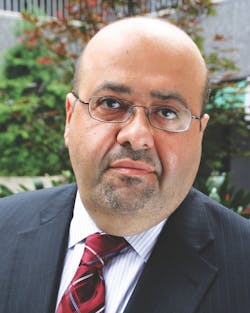Ali Poosti is acting division manager of Wastewater Engineering Services for the Bureau of Sanitation in the Department of Public Works in Los Angeles. Poosti can be reached at [email protected].
Adel Hagekhalil, P.E., BCEE, is assistant director of the Bureau of Sanitation in the Department of Public Works in Los Angeles. Hagekhalil can be reached at [email protected].
Leslie Streicher is associate editor for Water & Wastes Digest. Streicher can be reached at [email protected] or 847.954.7922.
- Historians say the first Los Angeles sewer was a small wooden pipe that burst after heavy rains nearly 2,000 years ago. Technology has come a long way since then, and today the city has more than 6,700 miles of sewer lines serving 4 million people. Recent rehabilitation efforts seek to evolve technology, revitalizing the sewer’s aging infrastructure while reducing overflows and stymying noxious odor. Ahead of the tours scheduled for WEFTEC.11 in October, WWD Associate Editor Leslie Streicher talked with Ali Poosti and Adel Hagekhalil of L.A.’s Bureau of Sanitation about the sewer overhauls.
- Streicher: What do the city’s sewer rehabilitations comprise?
- Ali Poosti: Los Angeles has divided the primary sewer systems into 26 primary planning areas. The existing secondary sewer system consists of 849 reaches, or 42.24 miles of 8- to 15-in.-diameter sewers. Approximately 65% of the sewers are more than 70 years old. About 3.7 miles in this sewer shed are recommended for renewal with an estimated construction cost of $2.6 million.
- Adel Hagekhalil: Out of our efforts to effectively manage our sewer system and reduce sewer overflows and odor, we prioritized our basins based on maintenance history, age, materials and potential for sewer overflows. Based on our analysis, it was determined that about 63% of sewer overflows are addressed in 33% of the system. That priority was based on the spill factor and was used for implementing our maintenance, inspection, planning and renewal. Our goal is to renew our system in the most cost-effective and efficient manner with the least impact to our communities.
- Streicher: How will sewer operations change after the overhauls?
- Poosti: The only change in sewer operation after rehabilitation is a decrease in the frequency of sewer cleaning and reduction of sanitary sewer overflows (SSOs). Unless there are blockages due to debris accumulation and root intrusion, SSOs and odor will be reduced.
- Hagekhalil: The completion of this sewer renewal project helps protect homes, businesses, schools and parks from potential street collapses, sewage backups, overflows and odor.
- Streicher: How is the project funded?
- Poosti: The project is a capital improvement project and is funded through the sewer construction and maintenance fund. The sewer service charge is assessed monthly for each household based on water and wastewater. All projects to complete 420 miles of sewers are scheduled for completion on June 30, 2014.
- Streicher: What can WEFTEC.11 attendees look forward to seeing on the Los Angeles sewer system tour?
- Poosti: The plan for the group is to tour four areas along one of the city’s major outfalls. The tour’s first stop is to visit a sewer rehabilitation project to show how a sewer line is rehabilitated using one of our latest technologies. The second stop is to witness how one of our maintenance crews cleans sewer lines using one of the city’s cleaning trucks.
- The group will also visit one of the advanced air treatment facilities (ATFs). The ATF draws foul air from a major city outfall’s headspace and removes hydrogen sulfide and non-methane hydrocarbons, releasing clean air.
- Finally, the group will go to the hydraulics laboratory to see a demonstration of sewer flow with a scale model of an actual drop structure.
- Hagekhalil: We invite you to come enjoy great fun and food, and see many innovative technologies, advances and practices in our water and wastewater industry.
Download: Here

